
Blue's Journey - Saving Planets and Princesses from Tyranny and Pollution...
Little Blue has a lot to do.
Blue's Journey
Platform: Neo Geo MVS

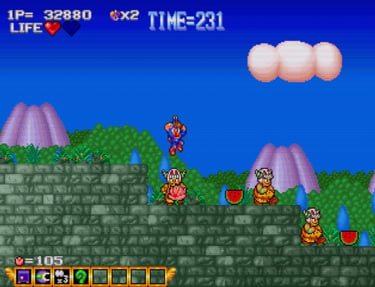


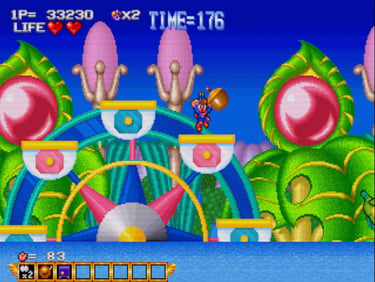

The early ‘90s arcade was filled with plenty of iconic sights, from Skee-Ball and greasy pizza to countless Street Fighter 2 cabs. But the most prevalent fixture were those red and white arcade machines that lurked in every arcade corner, their marquees backlit with an array of the newest games. While most arcade titles came confined to a single cab, these newfangled “Neo Geo Multi Video System” cabinets offered up to six different games. The result was a quirky novelty for arcade-goers, but a godsend for the arcade owner; rather than buying entire cabinets, the money-strapped manager merely had to purchase additional cartridges, turning the Neo Geo machine into something altogether antithetical to the norm. In short, the arcade machine became a coin-operated video game console.
For nearly a decade, these Neo Geo machines were seen in every arcade, their games becoming almost synonymous with the era. If Pac-Man, Donkey Kong, and Galaga defined the early ‘80s, games like Samurai Shodown, The King of Fighters, and Metal Slug easily represented the ‘90s scene. But for every iconic hit, the average Neo Geo machine usually contained several also-rans—those other games that glowed overhead but were overshadowed below. Every Neo Geo cab was identified by that one game everyone played…while the rest went otherwise ignored. And eventually, forgotten.
It’s an unfortunate fact masking a more important one—despite their ignominy, some of these overlooked titles were good. And Blue’s Journey is the perfect example. Bright, colorful, and fast…it was a platformer that should have become the platform’s Super Mario.
…
The Neo Geo brand is associated primarily with the fighter. Shooters, brawlers, and run n’ guns were also somewhat represented at the time, but definitely not the platformer. Over the Neo Geo’s decade or so of life, games made in the scrolling, hop-happy vein of Super Mario were rare to the point of nonexistence…Blue’s Journey being the rare exception. This early release came just before the hardware became repurposed—typecast, really—as a one-on-one fighting game machine. Colorful, challenging, fast-paced, and quirky to the point of weird, the Blue’s Journey was a glint of whim in a library composed mostly of grit.
And weird is not an exaggeration. Set on the planet Raguy, Blue is the lone soul who can save his world from the evil Daruma Empire. But Blue is an odd choice for a company mascot; far from cool Hedgehog or heroic plumber, he’s both a bi-pedal bug and a humanoid boy—an “Insectarian” per the game’s own literature. Indeed, it’s difficult to discern the “ends” of his bug-human amalgamation. Is the bug-eyed cap that adorns his head part of his actually physiology or just there for decoration…like the pelt of a skinned insect, perhaps? What Blue and his race of bug people really are is never explained.
Nevertheless, he’s a cute little dude. The Princess Fa, whom he hopes to marry, is also cute. And the rogue’s gallery of villainy he faces, what with their impressive range of behaviors and expressions, boast their own bizarro charms; pudgy birds bounce across the landscape like perpetual springs, tiny dinosaurs can be seen snarfing down flowers before spinning around to attack, and the end-level bosses always make their grand entrance with the same gusto of an action-packed anime. In fact, Blue’s Journey feels like the adaptation of a forgotten, or never-released, Japanese cartoon. It’s brimming with brilliant, stylized environments, flamboyant characters, and catchy music, making one wish there was somehow more context behind all the surreal proceedings.
But the gameplay is where Blue earns its greatest distinction. More than just hopping upon baddies, players can slap them upside down with a gigantic leaf, then toss the helpless creatures into other pursuers. Acorn bombs offer an alternate, longer-range attack that trades the enemy tossing for some explosive action. And a chakram-like boomerang can cleave through a line of enemies like a knife through melted cheese. Of course, players can also jump on foes and send them spinning into their peers in the game’s primary nod to Nintendo’s Mario.
Along with the firepower, Blue can shrink himself into an even teenier version of himself, which, above granting him greater speed and mobility, allows him to access secret areas. And secrets are everywhere in Blue’s Journey, from hidden shops and warp zones (called a Travel Agency here) to underground groves of clovers and other troves. Collecting flowers allows Blue to stop at the occasional shop, buying things like swimwear for better underwater controls, honey to heal a lost hitpoint (he can take two hits by default), and other often inscrutable accoutrements. Moreover, the oft denizen of Raguy will sometimes appear to offer a service of some kind, or simply provide a moment of humor between the usual hopping. The most amusing involves a rival named Red who’s intent on defeating Blue in a one-on-one duel. Players can choose to participate or give the bug the brush-off, but either way, the ornery opponent will demand a rematch at the game’s denouement…determining a good or bad ending.
…
Blue’s Journey is a surprisingly open-ended experience for what’s ostensibly an arcade game, but it might be these very coin-op trappings that undermine the overall package. Although cute, even clever, Blue’s interactions with the peoples of Raguy rarely amount to much. The money he earns rarely proves especially useful. The fetch quests he’s given are usually brief and overly simplistic. His shrinking mechanic feels under-utilized. And his pre-battle conversations with Daruma’s leaders are more incidental than pivotal.
The Neo Geo MVS would eventually be reimagined, and split, into two home consoles: the Neo Geo AES (Advanced Entertainment System) and the Neo Geo CD. Blue got a rerelease on the latter, a sensible switch for a game that seemed to teeter toward being a more open, choice-driven adventure. Had Blue been blessed with a home sequel, it would have likely emphasized the quest and narrative elements of his first game, becoming akin to a “lite” RPG in the vein of The Dynastic Hero or Popful Mail. Or maybe, even taking the structure of a Metroidvania. Blue’s heroic journey was one for the home, not for five-minute plays in the arcade.
Of course, a jump to modern day reveals there was no sequel, no second chance for a game crammed with too many ideas and too little room. The game achieved a niche audience that dwindled as the fighter became the platform’s genre of choice. Even among current Neo Geo enthusiasts, Blue’s Journey is regarded as little more than a curiosity. Nevertheless, the game is fun, different, and, for its time, even offered a captivating two-player, cooperative experience. And most striking, its otherworldly aesthetic still stands unique in a genre bloated with copycats.
Today, there are plenty of Mario, Mega Man, and Sonic the Hedgehog clones. But no one bothers to mimic Blue’s Journey. And honestly, maybe they should.--D
Publisher: Alpha Denshi
Developer: Alpha Denshi
Release: 1990
Genre: Platformer


Blue will meet a wide range of characters during his journey, most of them helpful...usually.
After the first realm is completed, players are given some choice in the next land they attempt.
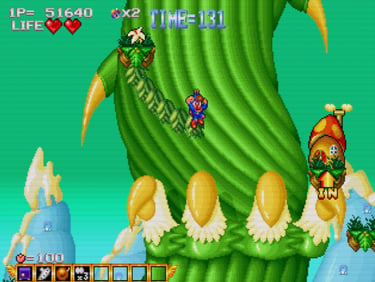

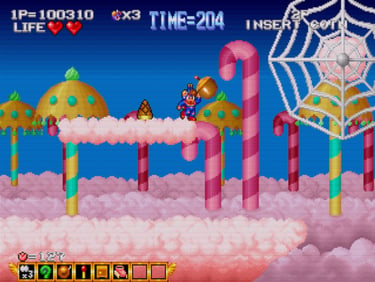



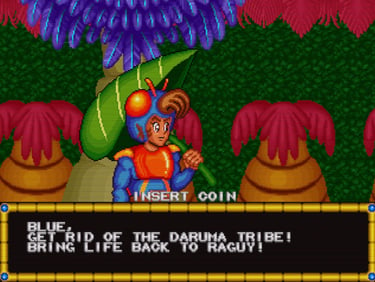

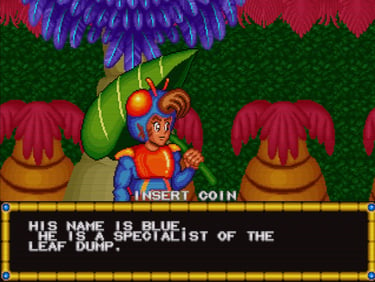



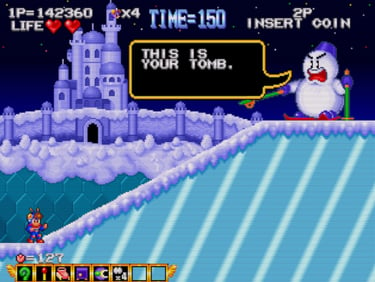

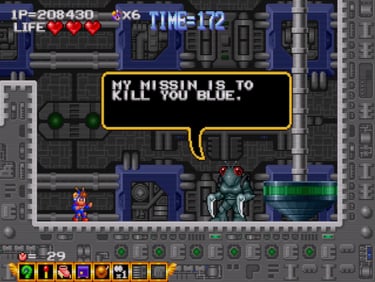

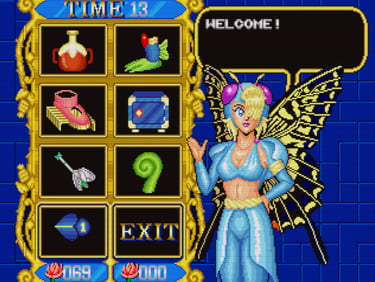




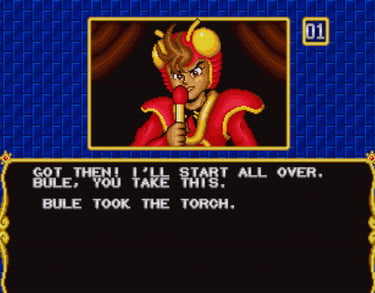


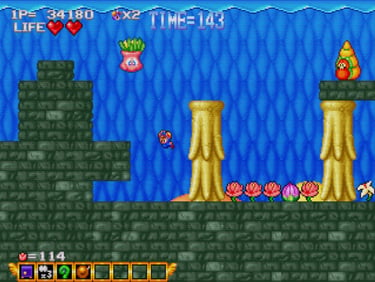

Blue can shrink himself into an even tinier tyke capable of accessing hidden crevasses and gaps for secrets. The smaller size also increases his speed...but leaves him unable to attack.
The game's art direction is incredibly varied, with backdrops both memorizing and timeless.
The game's attract mode shows a close-up of Blue, a dude armed with the so-called "Leaf Dump" and determined to stop that evil Daruma Empire.
The bosses are comical and, sometimes, pretty challenging until their quirks are learned. Most battles are preceded by a weird "what-if" conversation that gives the player some limited interaction.
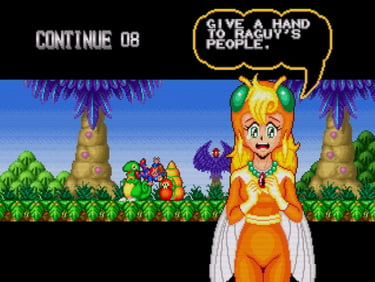

Princess Fa, the cutest bug that ever was.
Contact: lostnostalgiaproductions@gmail.com
Website: www.lostnostalgia.com
Like what we're doing? Please consider throwing us a dollar into our Patreon page's tip jar!


